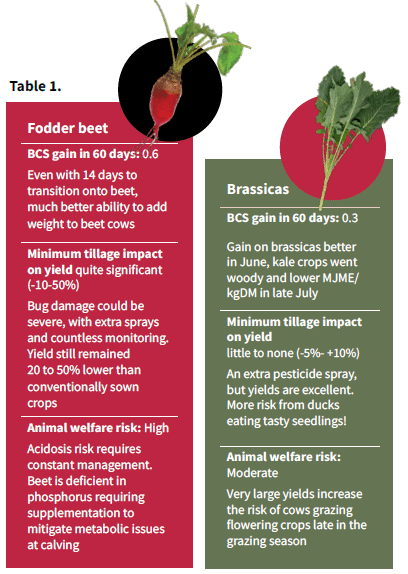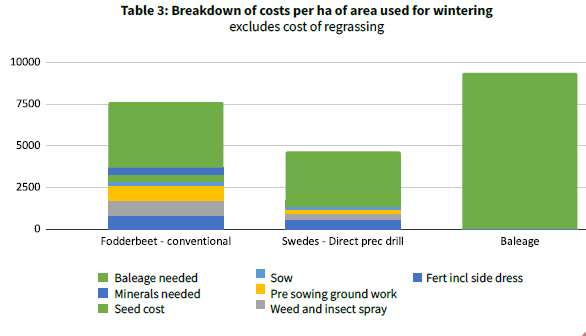Southern Hub shares wintering insights
Evolution and revolution have played their part in Southern Dairy Hub’s wintering. By Louise Cook.

We’ve been on quite a wintering journey at the Southern Dairy Hub (SDH), with some evolution and then revolution of the way we winter our cows. A quick recap – we keep all our in-calf animals home for winter on the dairy platform and for five years have wintered them on either fodder beet or kale.
Over those five years, we tried many different feeding techniques, but largely the diet stayed the same; 10 weeks on-crop after dry-off, and straight to the springer paddock. What we did change were the in-paddock tactics we used, predominantly to manage the weather impact on animal welfare and cow lying times.
After five years we are confident in planning for the following times if people choose to winter on these crops (See table 1).

Lower BCS gain on the brassica systems meant that our in-season management of cows was very important. At-risk cows were put on once-a-day milking and had priority in-shed feed, and if still too far from the BSC targets, we dried them off as early as March. With the continued increase in spring milk production and the increased tightening of our calving spread, we are confident the loss of late-season milk is outweighed by the gains in subsequent seasons.
As part of our continued research, as we set up for our sixth winter (2023), we initiated a step change in how we winter. At SDH, we understand brassicas – and by the way, we do love them! We also understand a lot about beet, and while it has challenges, for our industry it actually has a lot to offer and so we will continue to gain more understanding.
Brassicas are:
- simple and cheaper to grow (11c/kg DM)
- pretty simple to feed
- very consistent in yield under any cultivation method at SDH 12.5t/ha Kale and 16t/ha swedes
- Lower yield requires more area to be sown in crop to feed cows
- easy to transition onto
- enjoyed by the cows!
Brassicas have some challenges when it comes to meeting new standards under the National Policy Statement on freshwater. With the higher forage protein content, we know we have significantly more leaching directly under a winter crop of kale vs fodder beet. We also need more area/annum cropped into brassicas to winter the same number of cows.
Fodder beet is:
- more complex and expensive to grow (16c/kg DM)
- requires strict management to feed
- variable in yield based on weather conditions (from 19 to 25t DM/ha between seasons) and wildly variable based on cultivation method
- requires precise and slow transition
- loved by cows – they are addicted!
Fodder beet has some challenges when it comes to cow performance and longer-term impact on animals. Over two years we consistently saw calves born to fodder beet dams were 9% smaller (weight and dimensions) than calves from cows wintered on brassica. We also saw ongoing impacts in lactation performance with reduced total milk yield, unpredictable reproductive performance, and a higher risk of animal health issues in fodder beet cows.
So, for now, we are moving on from wintering on brassicas and fodder beet at 10 week beet/cow and looking at three new wintering approaches.
Introducing baleage wintering to Southern Dairy Hub, and less time in fodder beet
We test-wintered the proposed new wintering regimes in winter 2022 and our new farm systems trial starts June 1, 2023. The change included shifting half of our animals over to a baleage based wintering system, and one of the fodder beet herds coming off beet two weeks earlier to a higher protein baleage based system.
We’re hoping to be able to release some data on this shortly but, suffice it to say, we already know that baleage based wintering is very simple to manage for people and no transitioning is required BUT you are at risk of climate and market forces if you don’t have your own internal supply of baleage.
What does wintering really cost us?
What has been really interesting is the change in wintering costs we’ve observed at the Southern Dairy Hub as a result of our wintering system changes. Table 2, 3 & 4 includes information on what it costs us to deliver each wintering system.



*Spoiler alert* we know many of you have access to cheaper ways of achieving any one of these systems. You may have a freehold run-off block that you get baleage off, you may not count or measure your own time and vehicle costs moving feed around the farm, you may not consider baleage wrap recycling costs or you may have your own drill to sow your crops.
Unfortunately, we don’t have any cheap, free, discounted or easy sources of feed inside our costings. All costs are done at current market pricing and we consider all elements of providing winter feed for our cows.
In winter 2022 baleage was our most expensive wintering system followed by beet with brassicas coming in the cheapest. In addition to the direct costs of wintering, each farmlet needs to pay to regrass each hectare that they winter on as the land is unproductive afterwards.
At SDH, the land we winter on is within the milking platform area, and around half of the area we winter on each year has been used for springers during calving the previous spring which means we have to consider the cost of remediation for all areas.
You may ask why, for baleage wintering, we can’t just pop bales on to a new paddock of pasture in May?
Then we’d have less regrassing to do. For us, these bale-wintered cows also need pasture springer paddocks each season that still need re-grassing.
Plus, we have these bale-wintered paddocks that also need regrassing, unlike a crop system where the springer paddock would then be sown in-crop.
For the baleage wintering system, the baleage wintering area could be kept in the milking rotation all year and grazed for milk production, or we could remove the paddock from the farmlet and harvest baleage for wintering in which case the feed has an opportunity cost for not going to milk.
Whether we graze the wintering area or utilise it to make baleage the amount of surplus baleage within the farmlet is insufficient to winter on. For us approximately 30% of the baleage for wintering can be made within the farmlet with the rest bought in.
Evolving from winter 2022 to 2023
Changes for winter 2023 include reducing the baleage rate from 100 to 75 bales per hectare and lowering our winter stocking density. Last year there was much debate within our farmer reference group about how much grass to have on your baleage paddocks for cows, and we opted for approximately 2200kg DM/ha at the start of winter. This year it is going to be closer to 3000kg DM/ha to reduce the amount of bare soil during grazing. Even at 3000kg DM/ha, with cows offered 6.6sqm of fresh area/day pasture intake will only be about 1kg DM/cow/day. For feed budgeting purposes their total allocation for the day is expected to come from the baleage offered, so any grass is a bonus.
The fourth leg of the wintering stool – off paddock
Our last change is much farther away from our faithful brassica system, with some cows to be wintered off-paddock to test farm productivity when we aren’t impacting paddocks in winter and spring to hold our dry and pre-calving cows. The effective “extra” grass area for this farmlet should yield some productivity gains – but none of it comes for free.
In future this herd will be in off-paddock infrastructure (more to follow on the innovative hybrid structure to be built), and this year we will mimic them being off-paddock by utilising paddocks at our support block and wintering them on a baleage diet.
We’ll never stop evolving how we Winter at SDH. The intersection between cost, productivity, animal welfare, environmental footprint and people can feel like a spaghetti junction.
There is no simple, magical solution to the wintering of our cows, but there are facets of all the systems that seem to add together to a tidy solution and we’ll keep working towards finding it for our farmers.





